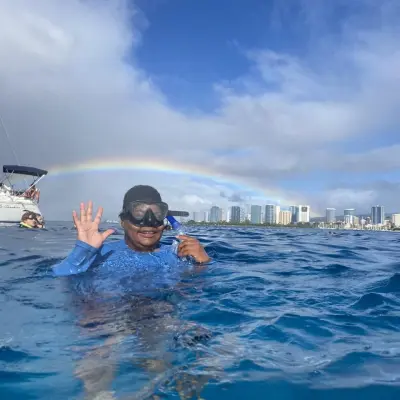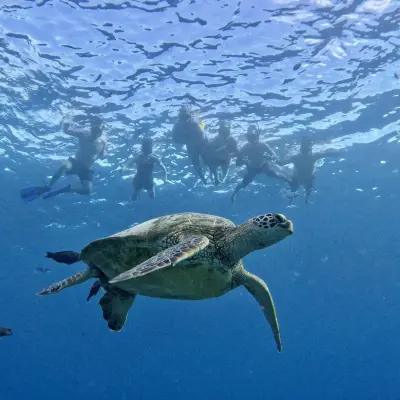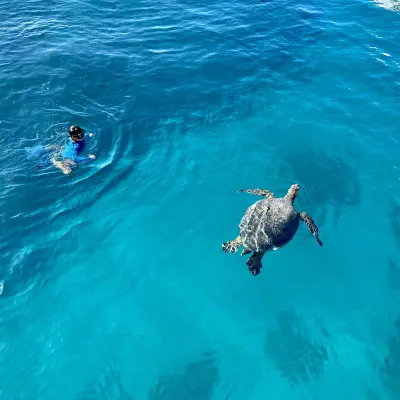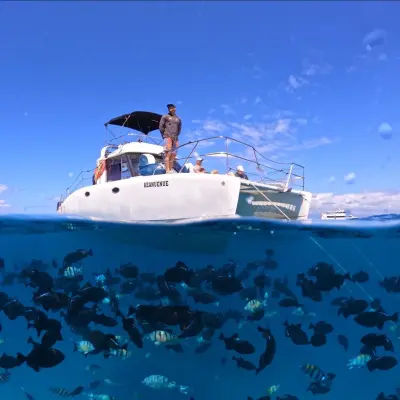Snorkeling in Waikiki, Honolulu
EXCELLENT
★★★★★
Based on 410 reviews


SELECT YOUR SNORKELING TOUR
Private Catamaran Cruise & Snorkeling
Explore beneath the sea on an incredible boat tour and guided snorkeling experience! Relax in the Hawaiian sun with your family and friends.
Semi-Private Turtle Snorkel & Catamaran Cruise
Explore Oahu’s offshore reefs on a small group shared tour for an unforgettable sightseeing and snorkeling experience. Turtles Guaranteed!
FROM
$109
Turtle Snorkel Tour “Big Kahuna”
Jump into an underwater adventure and enjoy this guided snorkeling tour of Waikiki’s famous Turtle Canyon Reef. Our 49-passenger boat is limited to only 16 people to make your experience awesome. All snorkel gear and instructions are included.
Turtle Sightings Guaranteed!!
FROM
$75
ABOUT SNORKELING WITH SEA TURTLES
Snorkeling with sea turtles in Waikiki offers an unforgettable aquatic adventure, allowing participants to immerse themselves in the vibrant underwater world of the Pacific Ocean. Waikiki Beach, renowned for its pristine waters and tropical surroundings, serves as the idyllic backdrop for this unique experience. Participants can expect a thrilling encounter with gentle sea turtles, swimming alongside these majestic creatures in their natural habitat. Guided by knowledgeable instructors, the activity is suitable for all skill levels, making it accessible to both beginners and experienced snorkelers.
Frequently Asked Questions
Where is the best Turtle Snorkeling Spot in Waikiki?
Snorkeling with sea turtles in Waikiki mainly takes place at the famous Turtle Canyons Reef. This reef is home to a few special species of fish that eat the algae growth on the sea turtle’s shell. Turtles come from all over the island to visit this cleaning station, you can expect 5 to 15 turtles at the reef at all times with a 99% success rate in turtle sightings. While the turtles do breathe air, allowing up-close encounters at the surface, they spend most of their time just above the reef getting cleaned up by the fish about 15 feet below.
This location is also very unique as it is home to a variety of tropical fish. Turtle Canyon is a no-anchorage zone. This means that boats are not allowed to drag their anchor on the seafloor damaging the reef. The result of this is a healthy ecosystem and coral filled with marine life. Among our turtles and fish, you can also see the occasional spotted eagle ray, sea urchin, moray eel, octopus, and much more!
Under rare conditions and variability in water visibility, Turtle Canyons may not be the best location on the coast that day. In this case, our experienced team can bring you to one of the other great reefs in the area so you can always have the best time possible.
- Snorkeling with sea turtles in Waikiki mainly takes place at the famous Turtle Canyons Reef. This reef is home to a few special species of fish that eat the algae growth on the sea turtle’s shell. Turtles come from all over the island to visit this cleaning station, you can expect 5 to 15 turtles at the reef at all times with a 99% success rate in turtle sightings. While the turtles do breathe air, allowing up-close encounters at the surface, they spend most of their time just above the reef getting cleaned up by the fish about 15 feet below.
This location is also very unique as it is home to a variety of tropical fish. Turtle Canyon is a no-anchorage zone. This means that boats are not allowed to drag their anchor on the seafloor damaging the reef. The result of this is a healthy ecosystem and coral filled with marine life. Among our turtles and fish, you can also see the occasional spotted eagle ray, sea urchin, moray eel, octopus, and much more!
Under rare conditions and variability in water visibility, Turtle Canyons may not be the best location on the coast that day. In this case, our experienced team can bring you to one of the other great reefs in the area so you can always have the best time possible.
Is a Private Charter or Shared Tour Better For My Snorkel Excursion?
Our shared tours are great if you are looking to stick with the designated itinerary and your focus of the tour is snorkeling with our wonderful wildlife, they also offered at accessible pricing for small parties. Our private tours offer unbeatable attention to service but also allow for a customizable itinerary. There is less time spent waiting for the group, you have the option to spend the time doing what you love most and going to the spots that fit your needs. For example, some of our guests enjoy going to other snorkel spots with a little less wildlife but much more privacy. If you’re concerned about your swimming ability or have very small children, private tours are perfect as you get our guide’s full attention. If you have a larger party 4-6 people the price difference to book a private excursion can be very minimal.
Our shared tours are great if you are looking to stick with the designated itinerary and your focus of the tour is snorkeling with our wonderful wildlife, they also offered at accessible pricing for small parties. Our private tours offer unbeatable attention to service but also allow for a customizable itinerary. There is less time spent waiting for the group, you have the option to spend the time doing what you love most and going to the spots that fit your needs. For example, some of our guests enjoy going to other snorkel spots with a little less wildlife but much more privacy. If you’re concerned about your swimming ability or have very small children, private tours are perfect as you get our guide’s full attention. If you have a larger party 4-6 people the price difference to book a private excursion can be very minimal.
- Snorkeling with sea turtles in Waikiki mainly takes place at the famous Turtle Canyons Reef. This reef is home to a few special species of fish that eat the algae growth on the sea turtle’s shell. Turtles come from all over the island to visit this cleaning station, you can expect 5 to 15 turtles at the reef at all times with a 99% success rate in turtle sightings. While the turtles do breathe air, allowing up-close encounters at the surface, they spend most of their time just above the reef getting cleaned up by the fish about 15 feet below.
This location is also very unique as it is home to a variety of tropical fish. Turtle Canyon is a no-anchorage zone. This means that boats are not allowed to drag their anchor on the seafloor damaging the reef. The result of this is a healthy ecosystem and coral filled with marine life. Among our turtles and fish, you can also see the occasional spotted eagle ray, sea urchin, moray eel, octopus, and much more!
Under rare conditions and variability in water visibility, Turtle Canyons may not be the best location on the coast that day. In this case, our experienced team can bring you to one of the other great reefs in the area so you can always have the best time possible.
Is the Ocean Calm and Clear in Waikiki?
Fortunately, Waikiki generally enjoys splendid weather and tranquil seas on most days. Positioned on the protected leeward side of the island, the area benefits from natural shielding against open ocean waves and excessive winds. While our appreciation for the ocean is immense, our operations are subject to the unpredictable whims of Mother Nature when we venture into the water. Rest assured, our seasoned team prioritizes safety and will never conduct a tour in adverse conditions. If we deem the water to be too rough, we’ll promptly contact you to reschedule or offer a full refund. It’s important to note that variable weather, fluctuations in water clarity, and changes in ocean conditions are to be anticipated. Regardless of the circumstances, our dedicated team is committed to ensuring you have an enjoyable experience.
Our shared tours are great if you are looking to stick with the designated itinerary and your focus of the tour is snorkeling with our wonderful wildlife, they also offered at accessible pricing for small parties. Our private tours offer unbeatable attention to service but also allow for a customizable itinerary. There is less time spent waiting for the group, you have the option to spend the time doing what you love most and going to the spots that fit your needs. For example, some of our guests enjoy going to other snorkel spots with a little less wildlife but much more privacy. If you’re concerned about your swimming ability or have very small children, private tours are perfect as you get our guide’s full attention. If you have a larger party 4-6 people the price difference to book a private excursion can be very minimal.
- Snorkeling with sea turtles in Waikiki mainly takes place at the famous Turtle Canyons Reef. This reef is home to a few special species of fish that eat the algae growth on the sea turtle’s shell. Turtles come from all over the island to visit this cleaning station, you can expect 5 to 15 turtles at the reef at all times with a 99% success rate in turtle sightings. While the turtles do breathe air, allowing up-close encounters at the surface, they spend most of their time just above the reef getting cleaned up by the fish about 15 feet below.
This location is also very unique as it is home to a variety of tropical fish. Turtle Canyon is a no-anchorage zone. This means that boats are not allowed to drag their anchor on the seafloor damaging the reef. The result of this is a healthy ecosystem and coral filled with marine life. Among our turtles and fish, you can also see the occasional spotted eagle ray, sea urchin, moray eel, octopus, and much more!
Under rare conditions and variability in water visibility, Turtle Canyons may not be the best location on the coast that day. In this case, our experienced team can bring you to one of the other great reefs in the area so you can always have the best time possible.
What Do I Need to Bring on a Waikiki Snorkeling Tour?
Prepare for an unforgettable Waikiki snorkeling tour by packing a few essentials to enhance your experience. Firstly, don’t forget your swimwear, ensuring you’re ready to dive into the crystal-clear waters of Waikiki. Reef Safe Sunscreen is a must, as the Hawaiian sun can be intense, and protecting your skin is essential. It’s recommended to have a towel handy for drying off after snorkeling. Even on a sunny day having a jacket or windbreaker is nice to have to keep you warm and sheltered from sea spray. If you have your snorkeling gear, feel free to bring it; otherwise, rest assured as we provide high-quality equipment. We do not allow full face snorkel masks due to safety concerns. Finally, a waterproof camera or underwater housing for your device allows you to capture the vibrant marine life you’ll encounter. With these essentials in tow, you’re all set for a fantastic snorkeling excursion in the tropical paradise of Waikiki. Join us for an exploration of the underwater wonders that await!
Our shared tours are great if you are looking to stick with the designated itinerary and your focus of the tour is snorkeling with our wonderful wildlife, they also offered at accessible pricing for small parties. Our private tours offer unbeatable attention to service but also allow for a customizable itinerary. There is less time spent waiting for the group, you have the option to spend the time doing what you love most and going to the spots that fit your needs. For example, some of our guests enjoy going to other snorkel spots with a little less wildlife but much more privacy. If you’re concerned about your swimming ability or have very small children, private tours are perfect as you get our guide’s full attention. If you have a larger party 4-6 people the price difference to book a private excursion can be very minimal.
- Snorkeling with sea turtles in Waikiki mainly takes place at the famous Turtle Canyons Reef. This reef is home to a few special species of fish that eat the algae growth on the sea turtle’s shell. Turtles come from all over the island to visit this cleaning station, you can expect 5 to 15 turtles at the reef at all times with a 99% success rate in turtle sightings. While the turtles do breathe air, allowing up-close encounters at the surface, they spend most of their time just above the reef getting cleaned up by the fish about 15 feet below.
This location is also very unique as it is home to a variety of tropical fish. Turtle Canyon is a no-anchorage zone. This means that boats are not allowed to drag their anchor on the seafloor damaging the reef. The result of this is a healthy ecosystem and coral filled with marine life. Among our turtles and fish, you can also see the occasional spotted eagle ray, sea urchin, moray eel, octopus, and much more!
Under rare conditions and variability in water visibility, Turtle Canyons may not be the best location on the coast that day. In this case, our experienced team can bring you to one of the other great reefs in the area so you can always have the best time possible.
Why are small-group boat tours better?
Our private, semi-private, and public tours are intentionally designed for small groups, ensuring that you receive the personalized attention you deserve for an exceptional experience. In contrast to companies with larger group sizes of 40+ people where safety tends to be the sole focus due to limited guide availability, we pride ourselves on providing a more intimate setting. For our private and semi-private tours, we maintain a ratio of 1 guide for every 6 guests, fostering a close-knit and secure environment. Even on our public tours, we keep groups small with 1 guide for every 10 guests. This approach allows us to not only prioritize your safety effectively but also to focus on those special details that enhance the overall quality of your tour. Our guests consistently appreciate these personalized interactions, highlighting them as a standout feature during their ocean excursions with us.
Our shared tours are great if you are looking to stick with the designated itinerary and your focus of the tour is snorkeling with our wonderful wildlife, they also offered at accessible pricing for small parties. Our private tours offer unbeatable attention to service but also allow for a customizable itinerary. There is less time spent waiting for the group, you have the option to spend the time doing what you love most and going to the spots that fit your needs. For example, some of our guests enjoy going to other snorkel spots with a little less wildlife but much more privacy. If you’re concerned about your swimming ability or have very small children, private tours are perfect as you get our guide’s full attention. If you have a larger party 4-6 people the price difference to book a private excursion can be very minimal.
- Snorkeling with sea turtles in Waikiki mainly takes place at the famous Turtle Canyons Reef. This reef is home to a few special species of fish that eat the algae growth on the sea turtle’s shell. Turtles come from all over the island to visit this cleaning station, you can expect 5 to 15 turtles at the reef at all times with a 99% success rate in turtle sightings. While the turtles do breathe air, allowing up-close encounters at the surface, they spend most of their time just above the reef getting cleaned up by the fish about 15 feet below.
This location is also very unique as it is home to a variety of tropical fish. Turtle Canyon is a no-anchorage zone. This means that boats are not allowed to drag their anchor on the seafloor damaging the reef. The result of this is a healthy ecosystem and coral filled with marine life. Among our turtles and fish, you can also see the occasional spotted eagle ray, sea urchin, moray eel, octopus, and much more!
Under rare conditions and variability in water visibility, Turtle Canyons may not be the best location on the coast that day. In this case, our experienced team can bring you to one of the other great reefs in the area so you can always have the best time possible.
Why is an Experienced Snorkel Guide Important?
Opting for a snorkel guide significantly enhances your safety and enjoyment in the water. Our guides are not only certified lifeguards but also possess extensive ocean experience, ensuring you can focus on the fun while they prioritize your safety. Navigating the reef and spotting wildlife becomes seamless with their expertise, preventing you from spending your entire snorkeling adventure fixated on the sand. Armed with a wealth of knowledge, our guides enrich your experience by sharing fascinating facts about the marine life you encounter and emphasizing the importance of preserving the fragile ecosystem of the ocean. Given the popularity of Turtle Canyons as one of Oahu’s premier snorkel locations, having an experienced guide becomes invaluable. They skillfully navigate the bustling crowds, mitigating the challenges of visiting a sought-after spot and allowing you to relish your time in the water even more.
Our shared tours are great if you are looking to stick with the designated itinerary and your focus of the tour is snorkeling with our wonderful wildlife, they also offered at accessible pricing for small parties. Our private tours offer unbeatable attention to service but also allow for a customizable itinerary. There is less time spent waiting for the group, you have the option to spend the time doing what you love most and going to the spots that fit your needs. For example, some of our guests enjoy going to other snorkel spots with a little less wildlife but much more privacy. If you’re concerned about your swimming ability or have very small children, private tours are perfect as you get our guide’s full attention. If you have a larger party 4-6 people the price difference to book a private excursion can be very minimal.
- Snorkeling with sea turtles in Waikiki mainly takes place at the famous Turtle Canyons Reef. This reef is home to a few special species of fish that eat the algae growth on the sea turtle’s shell. Turtles come from all over the island to visit this cleaning station, you can expect 5 to 15 turtles at the reef at all times with a 99% success rate in turtle sightings. While the turtles do breathe air, allowing up-close encounters at the surface, they spend most of their time just above the reef getting cleaned up by the fish about 15 feet below.
This location is also very unique as it is home to a variety of tropical fish. Turtle Canyon is a no-anchorage zone. This means that boats are not allowed to drag their anchor on the seafloor damaging the reef. The result of this is a healthy ecosystem and coral filled with marine life. Among our turtles and fish, you can also see the occasional spotted eagle ray, sea urchin, moray eel, octopus, and much more!
Under rare conditions and variability in water visibility, Turtle Canyons may not be the best location on the coast that day. In this case, our experienced team can bring you to one of the other great reefs in the area so you can always have the best time possible.
What Skills Are Needed to Snorkel in Waikiki?
While this activity is perfect whether you are a first-time snorkeler or an experienced explorer there are skills you should be familiar with. Basic swimming is a required skill to participate! While we do provide flotation so that you do not need to tread water and have a certified lifeguard in the water with you, we are still out in the open ocean and it is not the best place for your first-time swimming lesson. Swimming in general is a physically strenuous activity, using muscles that most people don’t use often. Additionally breathing while snorkeling is done only through the mouth which takes a little getting used to your first time doing it. You should be in good physical condition to participate. That being said, we have had guests of all ages, experience levels, and backgrounds. Our guides are very patient and will do everything they can to make your time in the water the best possible.
Our shared tours are great if you are looking to stick with the designated itinerary and your focus of the tour is snorkeling with our wonderful wildlife, they also offered at accessible pricing for small parties. Our private tours offer unbeatable attention to service but also allow for a customizable itinerary. There is less time spent waiting for the group, you have the option to spend the time doing what you love most and going to the spots that fit your needs. For example, some of our guests enjoy going to other snorkel spots with a little less wildlife but much more privacy. If you’re concerned about your swimming ability or have very small children, private tours are perfect as you get our guide’s full attention. If you have a larger party 4-6 people the price difference to book a private excursion can be very minimal.
- Snorkeling with sea turtles in Waikiki mainly takes place at the famous Turtle Canyons Reef. This reef is home to a few special species of fish that eat the algae growth on the sea turtle’s shell. Turtles come from all over the island to visit this cleaning station, you can expect 5 to 15 turtles at the reef at all times with a 99% success rate in turtle sightings. While the turtles do breathe air, allowing up-close encounters at the surface, they spend most of their time just above the reef getting cleaned up by the fish about 15 feet below.
This location is also very unique as it is home to a variety of tropical fish. Turtle Canyon is a no-anchorage zone. This means that boats are not allowed to drag their anchor on the seafloor damaging the reef. The result of this is a healthy ecosystem and coral filled with marine life. Among our turtles and fish, you can also see the occasional spotted eagle ray, sea urchin, moray eel, octopus, and much more!
Under rare conditions and variability in water visibility, Turtle Canyons may not be the best location on the coast that day. In this case, our experienced team can bring you to one of the other great reefs in the area so you can always have the best time possible.
What is the Boat ride to The Snorkel Spot Like?
So much more than just a shuttle over to the snorkel spot, the boat ride is one of the best parts of the trip! As we head out of the harbor and get an offshore view of the island, you’ll immediately notice the picturesque views of the coastline. The staggered skyline of Waikiki sits at the base of our mountain range providing a perspective like no other. Keep an eye out for the occasional pod of Hawaiian Spinner Dolphins and our seasonal Humpback Whales. Enjoy the cool ocean breeze as you coast along the waves. Our boats are built to handle Hawaii’s powerful ocean to give you a fun and comfortable ride.
Our shared tours are great if you are looking to stick with the designated itinerary and your focus of the tour is snorkeling with our wonderful wildlife, they also offered at accessible pricing for small parties. Our private tours offer unbeatable attention to service but also allow for a customizable itinerary. There is less time spent waiting for the group, you have the option to spend the time doing what you love most and going to the spots that fit your needs. For example, some of our guests enjoy going to other snorkel spots with a little less wildlife but much more privacy. If you’re concerned about your swimming ability or have very small children, private tours are perfect as you get our guide’s full attention. If you have a larger party 4-6 people the price difference to book a private excursion can be very minimal.
- Snorkeling with sea turtles in Waikiki mainly takes place at the famous Turtle Canyons Reef. This reef is home to a few special species of fish that eat the algae growth on the sea turtle’s shell. Turtles come from all over the island to visit this cleaning station, you can expect 5 to 15 turtles at the reef at all times with a 99% success rate in turtle sightings. While the turtles do breathe air, allowing up-close encounters at the surface, they spend most of their time just above the reef getting cleaned up by the fish about 15 feet below.
This location is also very unique as it is home to a variety of tropical fish. Turtle Canyon is a no-anchorage zone. This means that boats are not allowed to drag their anchor on the seafloor damaging the reef. The result of this is a healthy ecosystem and coral filled with marine life. Among our turtles and fish, you can also see the occasional spotted eagle ray, sea urchin, moray eel, octopus, and much more!
Under rare conditions and variability in water visibility, Turtle Canyons may not be the best location on the coast that day. In this case, our experienced team can bring you to one of the other great reefs in the area so you can always have the best time possible.
Green Sea Turtle Facts and Conservation Efforts
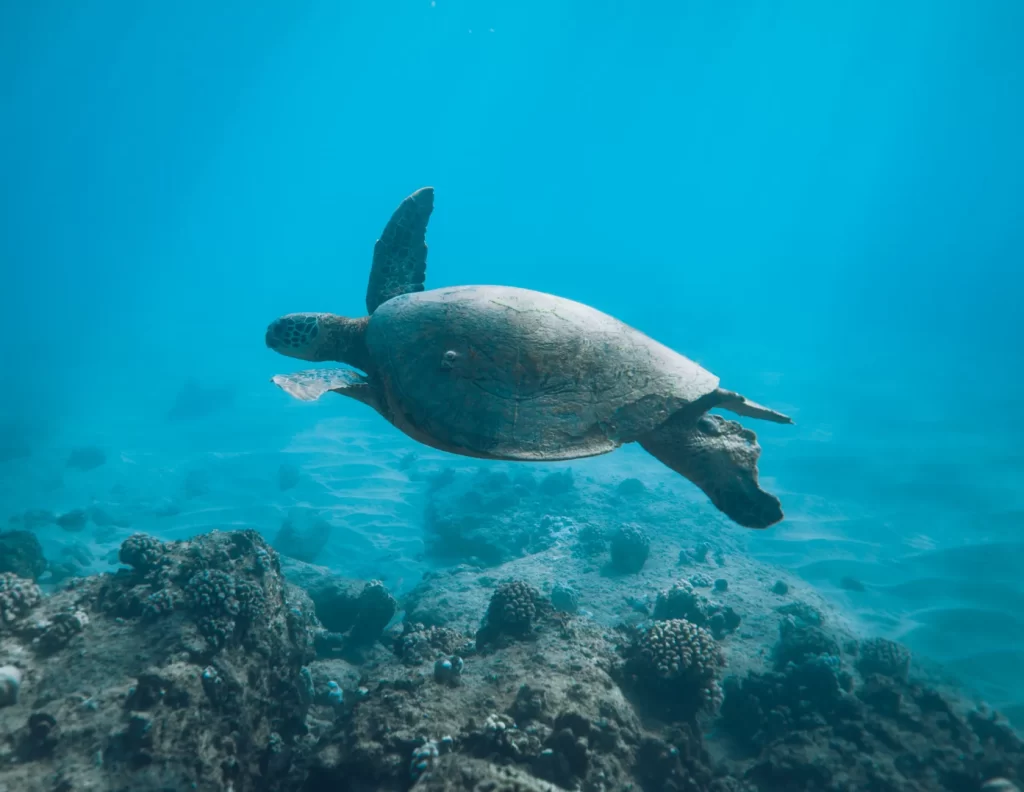
- Appearance: Recognized for their olive-to-black coloration and heart-shaped carapace (shell), these sea turtles can grow up to 3-4 feet in length and weigh between 200-500 pounds.
- Diet: Primarily herbivores, they feed on seagrasses and algae, contributing to the health of coastal ecosystems.
- Habitat: Hawaiian Green Sea Turtles inhabit nearshore waters, coastal areas, and coral reefs, making the waters around Hawaii an important part of their range.
- Lifespan: These turtles have a long lifespan, with some individuals living well over 80 years.
- Conservation Status: Considered a threatened species, Hawaiian Green Sea Turtles are protected by both state and federal laws to ensure their survival and well-being.
Rules When Interacting with Hawaiian Green Sea Turtles
Maintain a Safe Distance: It is crucial to keep a respectful distance when observing or snorkeling with sea turtles. A recommended distance is about 10 feet to avoid causing stress to the animals.
No Touching: Touching or attempting to ride sea turtles is strictly prohibited, as it can disrupt their natural behaviors and harm their delicate skin.
Avoid Blocking Their Path: If a sea turtle is swimming, snorkelers should not impede their movement. Allow them to navigate freely without interference.
Follow Tour Operator Guidelines: When participating in guided tours, adhere to the guidelines provided by tour operators and guides. They are trained to ensure a positive and minimal-impact interaction with the sea turtles.
Conservation Efforts
Protected Areas: Designated marine protected areas help safeguard sea turtle habitats, ensuring they have undisturbed spaces to feed, rest, and nest.
Research and Monitoring: Ongoing research initiatives focus on studying sea turtle populations, migration patterns, and health. This information aids in the development of effective conservation strategies.
Beach Cleanups: Community efforts and organized beach cleanups help reduce marine debris, a significant threat to sea turtles. Clearing nesting beaches of debris creates a safer environment for hatchlings.
Public Education: Raising awareness about the importance of sea turtle conservation and responsible human-wildlife interaction is key to fostering a culture of respect and protection for these remarkable creatures.


